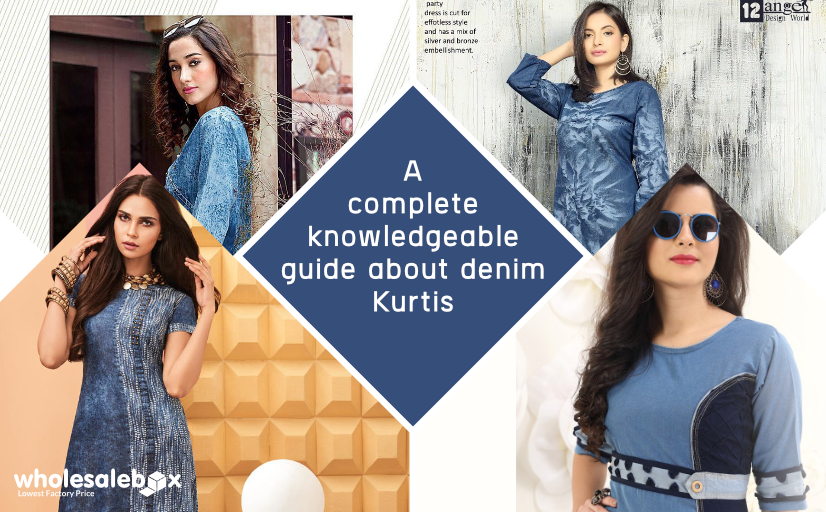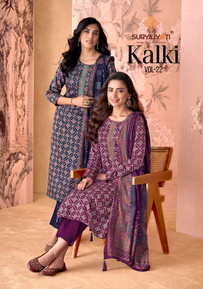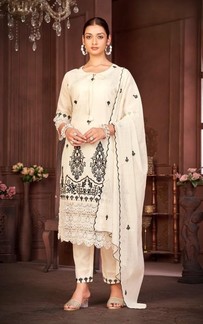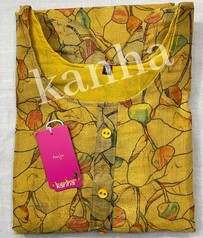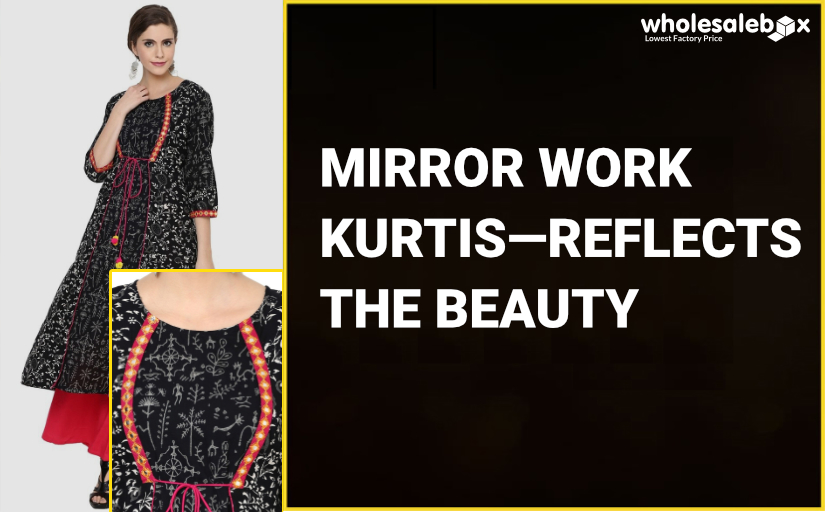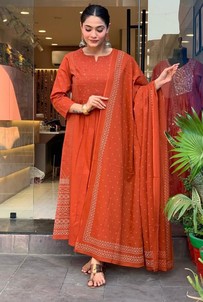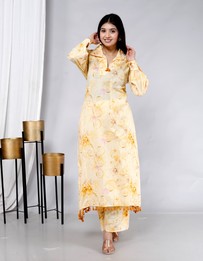Rajasthan located in the north-west of the country. The state is the largest in independent India, and also the land of the great warriors and princes flaunts. This state of India is rich in sand dunes, beautiful landscapes, great architectures and history, usually, when we talk about Rajasthan, the first thing comes to our mind is the bright colors. The state of Rajasthan is saturated with colors, even women in Rajasthan love to wear heavy colorful dresses with proper ornaments and footwear. There are many saree manufacturers, wholesale kurtis seller who are earning good because of availability of fabrics and work. Many women in Rajasthan wear sarees wrapped in a style that is of a particular region, others wear an ankle length kind of skirt known as lehenga with a cropped top called as chaniya choli, which is usually worn with a head covering. The other best option in fashion for women in Rajasthan is Kurtis, which is very much comfortable and can be worn in any occasion which gives very elegant and majestic look. The South Asian region has become a potential global center for textile and clothing exports.
A vast variety of world famous textile products are available in Rajasthan. Bedsheets, Quilts, Kurtis, Dress materials etc. Promoted by the Royals in the early 18th century the textile industry has grown and evolved a lot with craftsmen and artisans immigrating to the area over the centuries. Apart from Sanganer, Jaipur several other areas, mainly close to water sources developed their own printing techniques. Bagru, Akola, Jodhpur, Barmer are other important areas of textile printing in Rajasthan. Here, below many amazing fabrics of Rajasthan are explained. This blog is more helpful for the retailers, as all the information regarding fabrics is there like how it is established and in which market it is available and which city is famous for which fabrics etc.
India is the leading exporters of textile in Southern Asia. A major portion of textile and apparel exports go to the U.S and EU from the South Asian countries. Comparing the exports of U.S. & EU, one can observe that export of carpets and other textile flooring coverings to U.S. is on the top, while India’s cotton exports to EU is the highest. Exports of articles of apparel & clothing accessories and other made up textile articles, worn clothing and worn textile articles, rags etc. are also done on a large scale. For eg. export of articles of apparel and clothing accessories to U.S. was $1873 million in 2013.
India ranks among the top five global clothing suppliers. Apparel exports to India share 3.7% of the global readymade garment exports. India ranked sixth in the global trade of readymade garments with exports of $16 billion.
There is a huge margin in the textile industry for the retailers and when there are so amazing fabrics available to make customers and many tourists addictive to it.
EXCITING COLOURS OF BANDHANI
Bandhani is also known as bandhej, and piliya. It is one of the oldest forms of fashion textile. Also, women in Rajasthan wore bandhej as a symbol of luck. Bandhej is not just ready to locate fabric that can be easily made or purchased. It goes through a very long process before a cloth becomes bandhani. After the bandhej fabric is prepared it is formed into different styles like sarees, Kurtis or lehengas etc. Women in Rajasthan wear bhandej sarees during pujas at festivals, also not only women carry bandhej fabric, men also wear a turban of bandhej fabric.

Bandhej is very important to Jaipur. People living in Jaipur can say that bandhej fashion would never come to end.Today many lead designers are using bandhej in their collection and even many fashion retailers are also using bandhej in their contemporary designs. Bandhej is most popularly founded in different markets of Jaipur such as Johari Bazaar, Kishanpole Bazaar, Where different varieties of sarees, suits, and skirts in Bandhej are available.
THE VIBRANT COLOURS OF LEHARIYA
Women in Rajasthan wear lehariya in the end of Sawan month to celebrate the rainy season or Sawan with high spirits.

In Rajasthan, last day of Sawan is celebrated as Lehariya Utsav in which women gets the variety of gifts of lehariya in sarees and suits. Sarees of lehariya are made by dyeing the suitable fabric. The cloth that is used during the process is a lighter color, generally in cotton, silk, chiffon or georgette.
The cloth is tied and folded in such a manner that when opened post-dyeing, there is a striped pattern created on the cloth with color on every alternate stripe. Natural dyes were used and finished off with indigo for shades of blue, and Alizarin for the hues of red in the final stages. It is the most popular fabric found in the export market and has been showcased in fashion shows worldwide. The best market for lehariya in Rajasthan are Bapu bazaar in Jaipur, Kapra bazaar, tripolia, mochi market in Jodhpur etc.
BLOCK PRINTS OF SANGANER
Near Jaipur, there is a village of Sanganer, which is a major center for very fine block-cutting and printing. Almost 500 years’ old, Sanganeri printing gained high popularity. In the 16th and 17th centuries, almost 500 years old sanganeri printing gained high popularity in all European countries with its Calico prints and became one of the major exports of the East India Company.
Sanganeri is a hand block printing from Sanganer, a village in Jaipur, Rajasthan. Other than Sanganer there are many more villages like Jodhpur, Akola, Bagru etc which are famous for block printing. This art has been spread far and wide into the nature of Indian tradition and culture. The simple and creative style of block printing has made this popular among women in Rajasthan. This print is also available in kurtis, but now in the present scenario, it can be found on skirts, dresses, and scarves as well.
Sarees, dupattas, salwar-kameez, bed cover, curtains, scarves, and printed yardages (running cloth material), etc are the principal items which are printed here.

Both local and imported cloth material is used. At present,’mulmul’, ‘latha’and cambric etc are sourced from Jaipur.
BLOCK PRINTING AT BAGRU
Bagru, a small village in Rajasthan is situated near to Jaipur. It is popular for hand block printing of textile. Bagru is derived from the word’Bagora’the name of an island in a lake where the city was originally built and is popular for its palm fan production pattern.

In past, local people particularly the women folk used the bagru prints for wholesale kurtis. Patterns in rich colors like the indigo blue, alizarin, iron block and bright yellow were produced on coarse cotton cloth by indigenous processed of dyeing and printing.
DABOO BLOCK PRINT: AN ANCIENT PRINT TECHNIQUE
Dabu printing is also a distinctive art form found alongside Bagru prints.

In this, a design is represented onto the background cloth. This sketched design is covered with clay on which saw dust is dredged. The saw dust sticks to the cloth. As the clay dries, the saw dust get to stick to the cloth. Thereafter, with the help of different colors, the entire cloth is dyed.
The area where clay and sawdust mixture is present does not catch the dye and remains colorless. After dyeing and drying, the cloth is washed to remove the clay and the mixture. To cover the patterned area, the cloth is dyed again in a lighter shade for additional color.
MOCHI BHARAT: THE EMBROIDERY OF RAJASTHAN
Mochi Bharat is a chain stitch popular in Barmer district. The needle used for Mochi Bharat is known as Ari. The ari has a slash just above its point to form a hook that looks like a needle. The main motifs come from floral kingdoms, birds, and animals. It is usually created on shoes, animal saddles, and trappings. It is also founded in the decoration of textiles like cotton, silk, and velvet.

Rajasthani women are often seen in a ghagra and choli ornamented with this style of embroidery of mochi Bharat. In zari thread, Simple line patterns of leaves and flowers are created. In the villages, bolder patterns are preferred, where the entire surface is covered with brilliant colors and the designs are highlighted.

The design is often cut out on paper and then pasted on to the surface to guide the embroidery. In other cases, motifs are block-printed on the material, before it is embroidered.The finest centers of Jain embroidery are Pali, Jaipur, and Churu.
MOTI BHARAT EMBROIDERY OF RAJASTHAN
Moti Bharat is an art of Jalor district of Rajasthan. This kind of work is not done on fabrics. The transparent beads are worked on opaque white beads which forms the base, by tingle them together in various shapes and forms of birds, animals, human figures and other articles of day to day life, traditionally blue, green yellow and red colored beads were frequently used. Now a wide range of colored beads is available locally for the craftsmen to make use of.

Some of the common designs which are used repeatedly are Stylized human figures, geometrical designs, glimpses of daily life, horse and camel riders, an elephant with haudha, a horse with a carriage, the famous love legend of local hero Dhola and his lover Maru.

Various articles are prepared by moti Bharat like Purse, cap, toran, play articles, cradle decoration, showpieces.
APPLIQUE EMBROIDERY WORK
Applique is a needle work in which pieces of fabric with different shapes and patterns are stuck onto a larger piece to form some pattern or a picture. Applique is a technique used for decorating some sort of garments or fabrics. A famous example of appliqué is the Hastings Embroidery.While Appliqué is popular among kids and adolescents, it can be paired with interesting accessories such as hair ties, clip, bows, headbands, belts, clunky bracelets, and chunky neck pieces.

The colors of these accessories must match the color scheme of the Appliqué garment in contrast.This is done on bedsheets and bags too. Applique designs always look good for the longer duration of time. Applique fabric does not wrinkle. Applique work is mainly practiced in Jaisalmer, Rajasthan. Applique work of Rajasthan is mainly done on majestic red, purple, yellow, black, green and white fabric.
THE UNIQUE: MEO EMBROIDERY
Meos are the cultivators from Alwar and Bharatpur district of Rajasthan. Their tradition is very much similar to the Jats living in Haryana and Punjab. Meo fabric and the dresses of jat women in Punjab are embroidered with silk in Alwar. Practically it is known as Phulkari work.

Meo embroidery is done on footwear, dresses, cloak draped over the oxen and so on.
GOTA: FIRST CHOICE OF EVERY WOMEN
The metal embroidery of Rajasthan called as Gota work. The embroiderers of cities like Jaipur, Bikaner, Ajmer, Udaipur, and Kota are world famous for their distinctive styled Gota work. The gold embroidery of Jaipur, known as gota-work, is intricate. In Real Gota, Silver & Gold metals are used. But in routine, the base metal is copper, coated by Silver etc. Now the copper has been replaced by Polyester film which is metalized & coated as per requirements. This has resulted in better quality at lower cost. This Plastic Gota has good resistance to moisture & does not tarnish as compared to metal-based Gota.The different varieties of gotta are chaumasa, lappa, thappa, kiran, chatai and chip gotta. Gotta work is done on pure Georgette, Chiffon, Velvet & Silk whereas as in recent years synthetic fabrics are used for the production. As per the demand of the customers, all possible shades are available and the most commonly used colors are red, orange, pink, magenta, maroon and yellow. Gota is most popular among the women of Rajasthan.

There is no better choice than ‘Gota Work’ when the rich & heavy look is required in light weight. Also, it is low cost and durable. To create elaborate patterns, small pieces of zari ribbon are applied onto the fabric with the edges sewn down.
Gota can be folded in the shape of leaves and cut into small pieces.They are stitched in the form of continuous triangles on the border of the cloth.
In Gota work, the background is covered with the patchwork to highlight the work and make it more attractive and contrasting colors like pink and green or pink and red are mostly used.
DANKA: THE TRADITIONAL EMBROIDERY
Danka embroidery is a type of metal embroidery in Rajasthan. It is most popularly found in Udaipur, Rajasthan. It is an art which is primarily done by Udaipur’s Bohra community. At a workshop held in Udaipur this year, the practitioners faced great difficulty to train a group of 20 youngsters in the art. He proudly reported that at least three had ‘tremendous potential’ and he would train them further if enough business came his way when it all ended. The ‘danka’ is a small square plate, varied in size, but not bigger than 1.5 cm.

Though originally it was made of pure gold, now gold dankas with silver plated are used. To make the danka, thin, well-finished and polished silver sheets of 98 percent purity are electroplated in gold in strips of 30 cm X 2.5 cm. Then the strips are cut into 1.5 cm squares and the squares hammered with a stone implement till they resemble the tip of an ice cream cone.This method was earlier also known as korpatti-ka-kaam.

This decorative technique is usually worked on fabrics like satin, chiffon or silk fabric. The fabric is stretched tightly on a wooden frame before it is embroidered and the craftsman sits on the floor. Danka pieces are spread on the fabric as per the designs.
THE ELEGANT DABKA EMBROIDERY
Dabka is a very detailed sort of needle work. It is done after the fabric has been put on to adda and chappai is been done.

At least three to four workers are required for a detailed and fine work at the same time to work on the same piece. Firstly, a thick cotton cord is sewed on the pattern which is to be embroidered. Then on this cord prefabricated zari thread is looped on with the help of stitching needle. The patterns mostly made are of flers, leaves, or the national bird of India – the Peacock. Skilled kaarigar’s can also do french knots with the smallest size of dabka.
WOMEN’S LOVE FOR AARI WORK
A pen like a needle which resembles the shape of a crochet needle gives rise to an intrinsic form of artwork called the ‘Aari work’. This work is popular for its delicate and finest threadwork which enhances the essence of hand embroidery.

Aari work began with a simple procedure of using a lead pencil to sketch the design on the fabric, after which a needle was put to use which does hole along the lines of the design. Then the threaded needle was inserted into the fabric, and when it came up, it emerged with a loop. Through this procedure, the evolution of Aari work is been done with the help of fine stitched patterns.
As Aari work can now be seen in many types of garments, occasions like parties, religious ceremonies, weddings, and other formal occasions are perfect for dresses embellished with fine Aari embroidery. Apart from these occasions, this fabric can even be worn in all seasons, irrespective of any time of the year.
For maintaining the Aari work dry cleaning washes are recommended. Also, soft ironing and gentle hand wash are suggested to retain the quality of the stuff.
ZARI: THE PERFECT LOOK FOR INDIAN WEDDING
Zari! The word zari quickly brightens our eyes and brings glee to our faces, and at least for those people who are true ethnic wear lovers.Zari work is popular embroidery work used in almost all kinds of clothing such as Indian wear, accessories and home furnishings.
“ZARI WORK CAN BE of FOUR CATEGORIES: DABKA, SALMA, ARRI, AND BADLA.”

Zari is an embroidery work done in metal wires. Embroidery is the earliest origin. Important centers where saree manufacturers of zari work is done are Jodhpur, Jaipur, Ajmer, and Tonk. The art of this embroidery is mostly passed genetically where certain skills and techniques are taught secretly. The fabric on which zari work is done is first mounted on a wooden frame called adda, which resembles fully to the Indian charpai.

The charpai of the design which is to be embroidered is transferred on the fabric with chalk powder. Then the embroidery starts.
PHAD PAINTING: THE CHOIce OF RAJASTHAN PEOPLE
Phad painting is a style religious folk painting, mainly practiced in Rajasthan.This style of painting is traditionally done on a long piece of cloth or canvas, called as phad. Many bedsheets are made in which phad painting is done, which looks really elegant and royal. The narratives mostly of Pabuji and Devnarayan and of the folk deities of Rajasthan are depicted on the phads.

The Bhopas, the priest-singers traditionally carry the painted phads along with them and use them for the for the folk deities as the mobile temples. The phads of Pabuji and devnarayan are normally about 15 feet and 30 feet in length. Traditionally vegetable colors are used for painting the phads. Phad painting is mainly popular in Bhilwara.Shapes of these paintings vary from small to large, according to the stuff of the fabric. Only vegetable colors are used because these remain fresh for the longer duration. Phad paintings are done in Kurtis also. Phad painting is done by people of special caste- Chippa also called as Joshi’s who belongs to Shahpura, District of Bhilwara in Rajasthan.
THE ELEGANT PICHWAI PAINTINGS
Pichwai paintings are traditional paintings popular in Rajasthan. “Pichwai” mainly means “at the back”. These are lyrical artworks done on cloths which hang at the back of the idol of Srinathji, at Nathdwara. It is also found in other Krishna temples. These paintings are characterized by refined and detailed structures. These paintings are done in bedsheets which looks really elegant and gives royal look.

Pichwai paintings take a long time to complete, ranging from a few weeks to months. Usually, colors are made from natural sources and the brushes are made of the hair of horse, squirrel or goat.
However, with time synthetic materials also found their use in making these materials for these paintings. Presently, both traditional and modern equipment are in trend. Shivji Ram Mali and Shyam Sunderji Sharma are some of the amazing artists of pichwai paintings.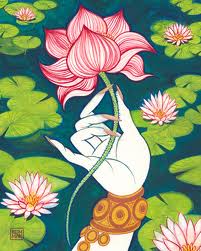
ZARDOZI WORK FOR ANY SPECIAL OCCASION
Zardozi uses pure gold and silver wire or the zari which is the metal embroidery. Therefore, this type of embroidery is known as zardozi. Thus Zardozi means sewing with gold string. Zardozi work is also known as karchobi. The embroidery emerges when embroiderer stretches the fabric tightly on a wooden frame. Zardozi suits are very much popular.

Zardozi is to be worked in two well-defined styles. The first, karchobi, is eminent by the density of its stitches on a heavy base material such as velvet or satin. It is usually seen on garments like coats, tent coverings, furnishing, and canopies. The second is kamdani, the lighter and delicate work, which is well-known in Rajasthan. Kamdani adorns elegant fabrics like silk and muslin. Although this kind of work is suitable for heavy Kurtis or suits, these days it is most available in bridal wear. ‘
The design is first outlined on the fabric and mixed metallic wires and shapes are spread out over it. The motifs in Rajasthan, used in the embroiderers are inspired from different shapes and sizes of gold, silver wires and discs. The badla, a flat wire with a thread base, the salma is coiled and springy, while the dabka is a thin tightly coiled wire. Asitara is a tiny ring of metal that resembles a star, gijai is a circular, thin stiff wire and the tilla is a flat metal wire.The most expensive and ostentatious examples of zardozi include semi-precious stones and pearls. Zardozi is done in suits, lehengas and even bridal lehengas and heavy Kurtis etc. It is majorly available in Jaipur, Rajasthan.
YOUNGSTERS LOVE FOR PATCHWORK
Patchwork is mostly used in making quilts. But it is also used in making warm jackets, skirts, wall hangings, cushion covers and other items of clothing.

When patchwork is used to make a quilt, the larger patchwork becomes the “top” of a three-layered quilt and the middle layer being the batting, and the bottom layer the backing. To keep the batting from shifting, a patchwork is often quilted by hand or machine using a running stitch to outline the individual shapes that make the pieced top, or the quilting stitches may be random or highly ordered overall patterns that contrast with the patchwork composition. The patchwork, batting, and backing are loaded onto the frame and in some systems, each layer can be tensioned independently.
There are three ways used to make a patchwork:
• The Block– Patchwork is divided into square shapes made up of light and dark or contrasting colors. Blocks can also have several different patterns. Blocks are typically around 20 cm to 25 cm. Some strips of contrasting fabric forming the patchwork blocks from each other. Some common patchwork block is Log Cabin, Drunkard’s Path, Bear’s Paw, Tulip, and Nine Patch etc. Block patchwork can be done in any type of garment like Kurtis, jackets, tops, scarves and in any kind of western wear.

• Overall-Overall patchwork designs are incrementally pieced out like geometric shapes stitched together to form a larger composed design. To create a specific effect the colored shapes can be pieced randomly or follow a strict order, e.g. value progression, or checkerboard effects. Patchwork such as Hit or Miss, Clamshell, back-stitch, needle weave, criss-cross and Starburst identify are some overall patchwork structures.
• Strip Piecing-Strip piecing means stitching the pieces of fabric together in repeat patterns into long strips and then stitching the strips together lengthwise. The patchwork strips can be alternated with strips of contrasting colors. It is mainly done in quilts.
Nowadays, patchwork is in huge trend and also popular among youngsters. Patchwork is found in garments like scarves, dresses, jackets, tops, Kurtis etc.
THE ROYAL KHARI PRINT
Khari is a special style of printing, used to enhance the designs on a cloth. This technique is mainly popular in Jaipur, Kota, Chittorgarh districts and in Kishengarh region of Rajasthan.

The process of Khari printing is done by mixing the Gold or silver powder also mixed with certain ingredients, is layered directly on the patterns of printed clothes. This creates a special effect on the clothes.
Khari prints are used in skirt borders, blouses, sari ends etc. Floral patterns are the most common designs created using this technique.Sarees with Khari print looks really good and elegant.
Khari printing is a technique in which a paste is used which is pushed through a metal container with a specific design cut out from its base leaving that design on the fabric. It is a method often used to put either metallic or white direct print either over an already block printed fabric creating a highlight or a single design in its own right. It is a highly skilled and labor-intensive process with only a small motif produced by each impression. Dry cleaning should be avoided in Khari printing.
There are similar fabrics available in Orissa too. You also read Double your sale by selling awesome Odisha fabrics.
MAJESTIC KUNDAN WORK
Kundan embroidery is the combination of Zardozi and Kundan work. The basic process for Kundan work is done after completing the Zardozi embroidery using gold and silver threads, gemstones and pearls are studded on to it. Kundan on fabrics is being done from the time of Mughal era where it flourished in Rajasthan.

However, just like Zardozi, this work also flourished due to the increasingly high costs of gold and gemstones. Artisans from all over the country coincide to Rajasthan to learn and perfect this art. Mostly, Kundan embroidery is done on silk sarees but in modern scenario designers prefer the embroidery to be done on Georgette and Chiffon fabrics, which looks really elegant and majestic.
So consumers and especially retailers are you all looking for these amazing fabrics?here is the solution for you all where all these fabrics are available altogether.
As it is very tough for the tourist who loves Rajasthani culture and tradition to reach out Rajasthan and purchase some popular fabrics which they love. Also, it will cost them very high because of traveling cost, lodging etc.
So, the solution for this problem is to get all the products online, WHOLESALEBOX is the one who can help out these people by providing them a great variety of garments with amazing stuff. Wholesalebox is the online platform where all types of products for men, women, kids, even home furnishings, accessories, and footwear is available. The shopkeepers or retailers can buy the products from WholesaleBox at the low prices and they can sell it with high-profit margin. The wholesalebox works at 25-35% margin. The aim of WholesaleBox is to give highest profit margin to the retailers.
Apart from all, the products which WholesaleBox provides are of best quality. All these Rajasthani fabrics are available at Wholesalebox at very low prices. Sarees, Lehangas, suits, bedsheets etc all are available with these embroideries with the best quality.
